Actplan Limited: Fleet Management Engineering Functions
The centralization of Actplan limited fleet management engineering functions
The world of organizations has always been confronted with major changes. These changes, varied, can take several recurring forms and are generally known as reorganization, restructuring or even revitalization.
In this perspective, the company Actplan is faced with an internal problem mainly in the logistics, which creates loss and waste of resources. This is compounded by conflict and ignorance of the staff who no longer know what role to play.
Thereby, the report that follows provides a general solution to the change required by the new CEO, which is to centralize the system VFMS into the corporate headquarter, and to dismiss some of the staff. Thus, the method of change of Kurt Lewin will be used for this case and the plan will be mainly oriented towards communication, analysis as well as the training.
Further that, since a change manager will not be able to do this plan on his own, the creation of a team and a new change manager have been approved. Thus, the analysis made on the different behaviour required of the individuals. Allowed us to compose this team using the method of Belbin team roles. Thereby, the new change manager will be a Coordinator, while the team will consist of a Plan, a Monitor evaluator, a Resource investigator, and an implementer.
I. Change management :
I.1. Reason for change:
Actplan is a multinational engineering company with a divisional structure specialized in the manufacture of electrical components for domestic and industrial use. The company is divided into several districts that have full control over their geographic area and are headed by division managers. These ones manage the technical, marketing, financial and commercial aspects, and are directly responsible to the general manager in the corporate headquarters. There is thus both a great autonomy of the different districts and a strong centralization of the powers around the divisional managers.

Figure 1: Actplan company organisation
The main mission of each division is the distribution and marketing and maintenance of the different products in their respective regions while managing the administrative aspects proper to them.
However, after the former CEO retired and the set up a new CEO has been done, this one has processes to an evaluation of the entire company, so the financial reports showed gaps in the resulting division resulting in the waste of resources and loose of money. With particular intent on the logistics side where resources are used randomly and without control.
I.2.Type and Scope of change:
Since the ideas are initiated by the hierarchical summit organizing and planning the process of innovation. We can conclude that the process of change is of the top – down type. In this case, the CEO will take the steps and promulgate measures to obtain the participation of the actors concerned.

Figure 2: Top down diagram
In this perspective, in order to share his vision of the situation as well as the purpose of change, the meeting that brought together the CEO and the different managers of the DHQ and CHQ concluded that the main changes will be:
- Full stakeholder’s benefits with transparent streamlined business
- Centralisation of a new VFM&S and fleet acquisitions and removing the old system.
- Transfer of functions from DHQ’s to CHQ.
- 2 years change transition.
I. 3. The change management approach:
Being designate for change, the first step before starting the change process itself, must be an interrogation on the definition of the goals and the relevance of the change. Why change? What ambition to aim for?
This step of observation concerns the preliminary analysis of the situation, with briefings with the project manager or the CEO, or We will seek to determine what we want to change and how far the change must go, how This is likely to solve the problems found and to improve the degree of adaptation and efficiency of the organization These aspects relate in particular to the organizational diagnosis.
According to Autissier and Moutot (2003) there are two criteria for characterizing changes, so they consider that change is defined according to its intentionality and rhythm:
• the criterion of intentionality (voluntary vs. imposed)
• the criterion of temporality (brutal vs progressive)
The meeting of the axes progressive / brutal and imposed / voluntary allows to identify 4 types of change that we can see in this matrix.
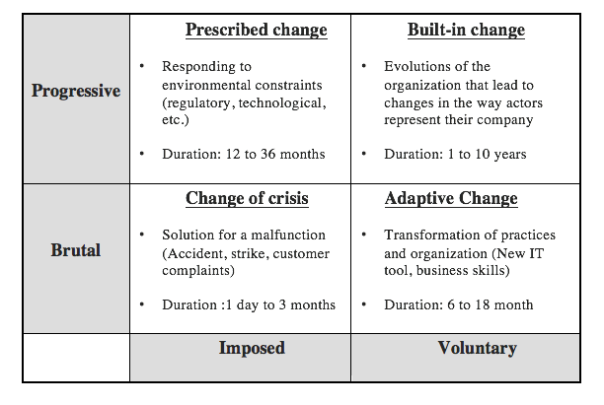
Table 1: Type of change matrix
Thus, taking into account the situation of our study case, the change will be prescribed, in the sense that it is imposed by the CEO and progressive over a period of 2 years.
Also. According to Kurt Lewin, the whole process of change follows roughly a progression that can be described in three main phases (Figure 3), this tool will be used for the change management process in this case of study.
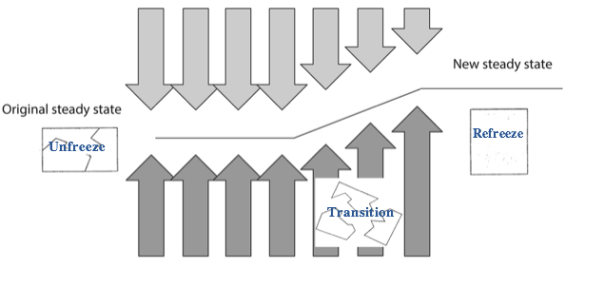
Figure 3: Kurt Lewin change process
The keywords and the main process for each step are:
• Unfreeze:
– Helping actors understand change and its causes;
– Informing about objectives and issues.
– Expect a resistance.
• Transition:
– Help actors to change: listen, understand, support, encourage, accompany, debate and respond.
– Put in place the necessary training facilities.
• Refreeze:
– Supporting individuals in their new roles.
– Encourage reflection on learning and change.
– Celebrating Success and Behaviours.
I .4. Change management process:
a-The unfreeze:
The first stage of the unfreeze, begins with a large communication campaign plan (Annex 1), for this purpose, each DHQ and CHQ manager has the task of communicating the current events for his team, the purpose of this manoeuvre is to reduce mistrust and stress regarding the new CEO in a way where it remains a new unknown person for the staff of the company, unlike managers who collaborate with them longer.
During these communication sessions, we handed out to managers a survey for all employees of the organization. This self-administered survey is composed of closed-ended questions, with a cover letter, providing the necessary recommendations for responding, including anonymity and confidentiality.
The survey consists of five parts (Annex 2): the first one looks at the working environment; The second on changes, and the third on general issues related to the workplace;
The results of these survey will be counted and treated later to find points of the old system failure and to see emotions as well as to detect possible resistance. In addition to meeting the reality of the environment, several meetings took place with the union and the members of the committee. These meetings aimed at ensuring consistency between the survey and the organizational reality.
b- Transition:
The transition stage is the most delicate step of the change, in the way where it is here that the communication plan put in place will be implemented.
Following the CEO’s recommendation, the first change was to centralize the VFMS system, thus controlling the logistics fleet will be supervised by the CHQ with the mission of tracking different lorries, as well as support for maintenance operations, by installing GPS tag and a GSM Diagnostic System in each truck.
However, this change will greatly alter the way the engineers works in each DHQ. The biggest fear is the use of a centralized system for people who have been working independently for a long time. The manipulation of this system leads to fears for both “good” and “bad” engineers especially that we are in a transition phase where the worst engineers are afraid because they will be controlled and the best are afraid of the new technology.
Even for the staff of the CHQ where the new system will be installed, it will bring a new unknown task to all, which will generate fear, stress and the anguish of spending more hours to work.
At this level of the transition and before starting the training of the new system, forms of resistance can be imposed and creates conflicts, especially with the potential for the imminent dismissal of the staff. Thus, the brief observation phase that will follow in collaboration with the human resources of each division will bring to light the disruptive elements that will totally contradict the new system. This denial will be mainly in the form of absenteeism and refusal of collaboration; those will have to be decommissioned according to the CEO’s recommendations, the idea is that the training of these elements will be a waste of money and time. On the other hand, the development of an early retirement formula for employees aged 50 and over with at least 20 years of seniority will be negotiated with the union so that we will save time as the training of older people will take longer.
Having the field clear, the training phase on the new VFMS system and the accompaniment of the staff will begin. Training the most important step in change projects because this brings knowledge about the current change in the project, technology that come with it and understanding to the future role, so the methodology of training needs to be adapted to peoples, their roles and their functions.
Thus, E-learning or distance learning, maybe a technological opportunity for this project. In fact, this method brings, many advantages:
-It adapts to the constraints of time and the organization of each one.
-It allows to work autonomously and independently.
-It develops the spirit of curiosity and research.
-The cost of training is reduced (booking class rooms, traveling trainers).
-It avoids transport costs due to geographical distance.
c- Refreeze:
During this stage, new practices become “natural”. They integrate in the person and in the context. Now is the time to make adjustments so that residual problems do not compromise the results obtained. The aim here is to reinforce the changes made and to make them resistant to possible changes or regressions.
In conducting change, observing these phases ensures better chances of achievement and is part of a rather participatory mode of change. It makes it possible to target the actions undertaken according to the stage in which we are located.
Thus, the template in Annex 3 summarise the change management plan and the new company organisation will be as shown in the following figure.
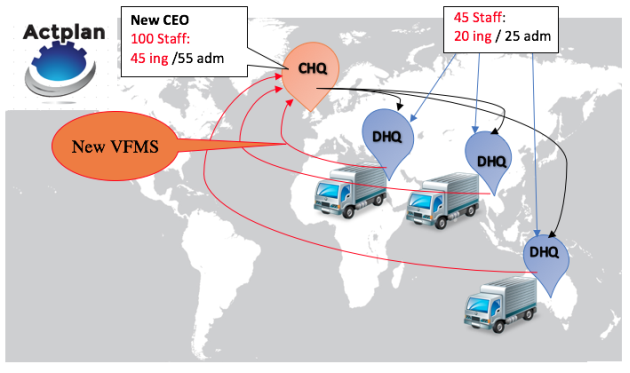
Figure 4: New Actplan organisation
A change manager cannot plan change by himself. In order to achieve this transformation, the manager has to be surrounded with the necessary resources throughout this phase, thus creating a team that will help and support change is mandatory. Moreover, in this case being close to the withdrawal of the current manager, a new replacement has to be set up in order to continue the procedures after the departure of the enclosure
In this circumstance, it is necessary from the outset to work closely with the human resource department and the Belbin’s methodology, with one main aim being to detect leadership.
II.1. The definition of a leader
The leader is the one who possesses a strong potential who can be subjected to experiments to develop this potential. It has its own specificities that appears during the evolution within the company. Thus, the leader is the one who opens the way for individuals to make major changes. It is the who influences others through his credibility, ability and commitment.
In our case study, the task of a leader is to produce the change. this task goes beyond the control, recruitment and problem solving; It is about meeting the challenges in order to ensure growth, performance and learning, and he will be called upon to bring those around him to communicate change, adjust their values, modify their perspectives and to acquire new habits. To do so, he must detect opportunities and locate existing skills.
II.2. Defining the new change manager:
Following the definition above and following the Belbin’s team roles (Figure 5), the new change manager within the company will be designed following the test, the proper role for manager in this should be a coordinator, Thus the choice will be made among the potential leadership that will have the most concordance in this role by the test observer.
Moreover. This new change manager will be designed at the early stage of the process change, to let him have all the knowledge about every step before the retirement.
II.3. The establishment of a change management team
At the start of the project, the manager will set up a change management team, which will be different from the functional team in charge of managing the project itself. The aim is to create a multidisciplinary and motivated team with the skills and competences to manage the change process over its entire duration: group work capacity, degree of mastery of the project management culture, capacity of animation and especially negotiation.
The creation of the change management team can only be done with internal resources, but the use of external providers is often necessary because external resources can be a guarantee of objectivity and neutrality, and they have skills, Methods, and communication techniques that do not have internal resources.
Thus, following the Belbin test, we should find resources can be useful in communication actions because they know the structure, can identify the right people, or be informed more quickly of possible obstacles.
Finally, the typical change management team roles will be: A Plan, a Monitor evaluator, a Resource investigator, and an implementer. With this configuration, we will have two cerebral roles for the planning and the monitoring and a one people orientated role for the investigation, and finally one action orientated roles for the execution.
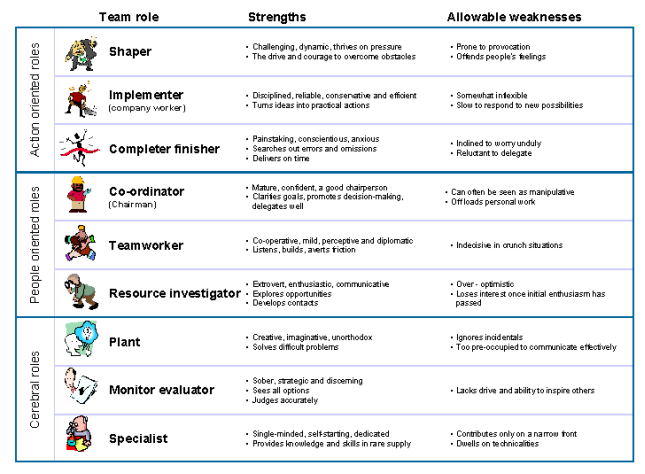

Figure 5: Belbin’s team roles
The Communication Plan:
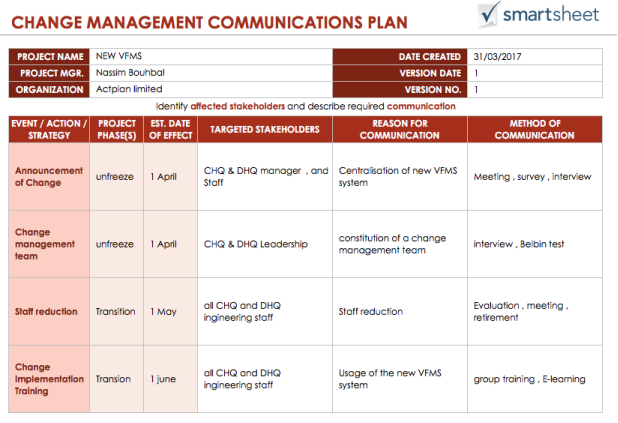
(Template source: https://www.smartsheet.com/free-change-management-templates)
The survey Sample:

(Template source: http://www.hr-survey.com/EmployeeSurveyQuestions.htm)
Change management plan:


(Template source: https://www.smartsheet.com/free-change-management-templates)